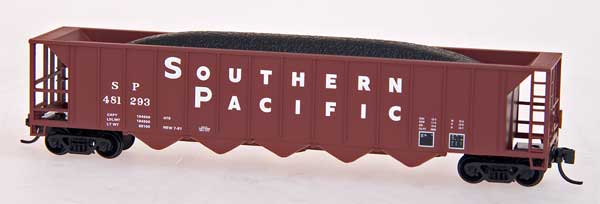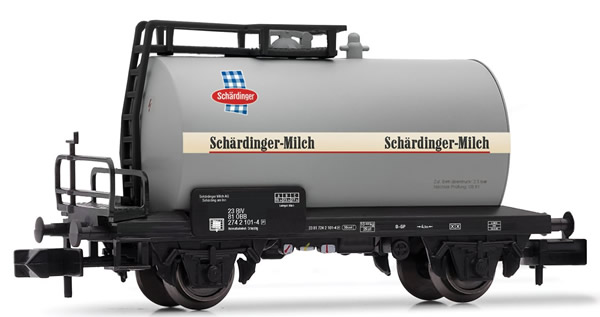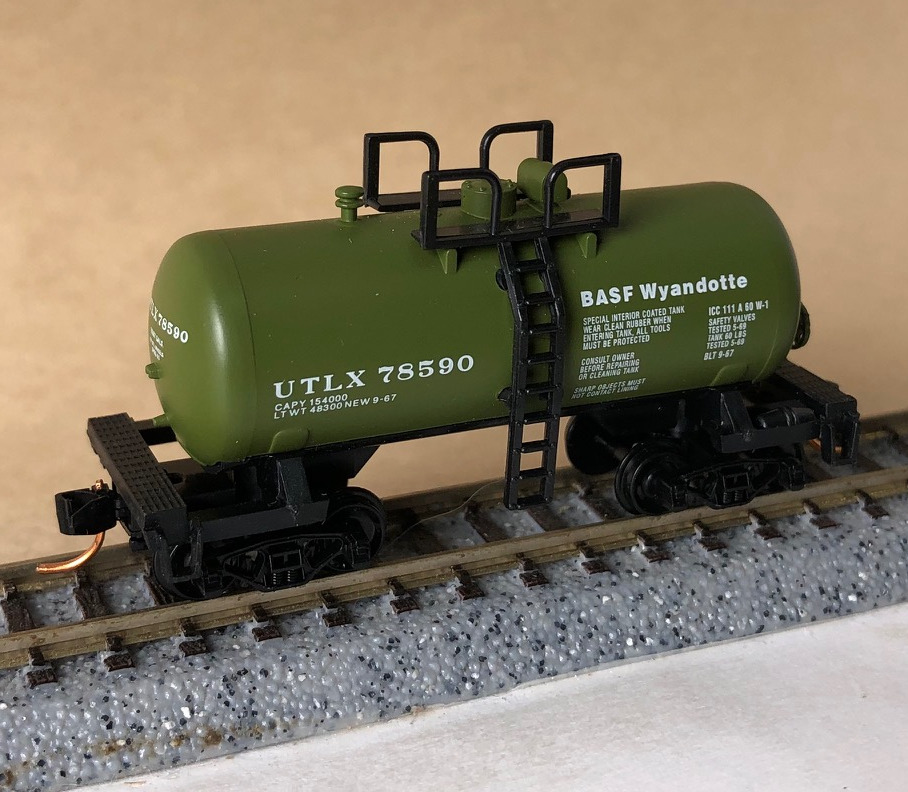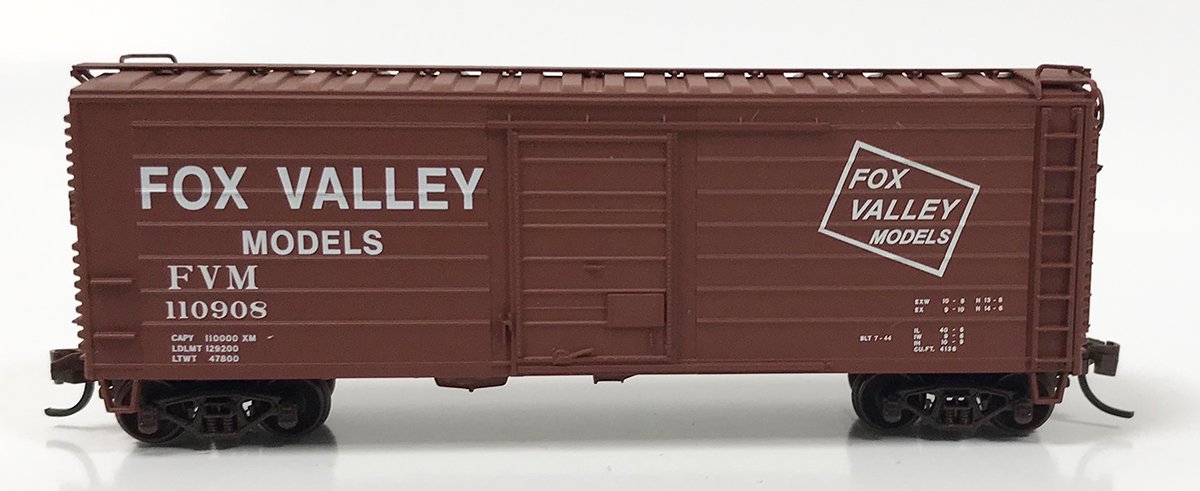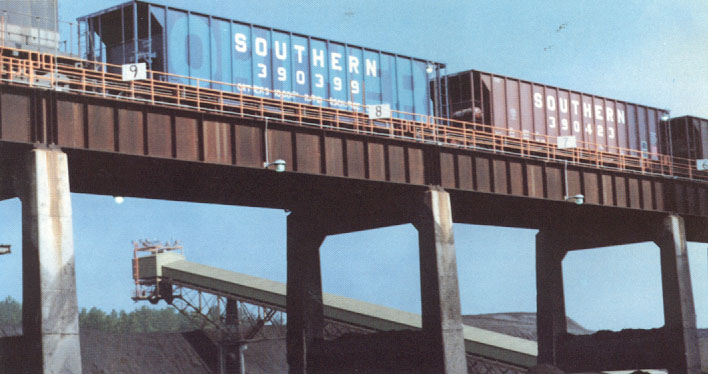Model Information: Precision Master first released this body style in kit form in 1986. Later on, they released the same body as a RTR (Ready-to-Run) model. In 2005, Red Caboose acquired this tooling from PM. Red Caboose has released this model in RTR form. When Red Caboose folded its doors, Fox Valley acquired the tooling and produced releases with the Fox Valley brand.
Different releases had some fairly important differences. Some Red Caboose releases have their coal loads permanently glued in place. This is a shame because the loads are pretty cheesy and if they are permanently affixed, then they cannot be replaced by high quality third party loads such as are made by Hay Brothers. Trucks and couplers vary as well. Early Red Caboose releases feature Micro-Trains trucks and couplers with MT's "standard" wheels. Later Red Caboose releases use cheaper Chinese knock-offs of the MT trucks (to save a few $ we assume). Fox Valley versions have body-mounted (MTL-knockoff) couplers using the new adapter designed by Trainworx.
These models are overall pretty good with a typical 1980s level of detail in the molding. The printing on all the manufacturers' models is quite good. However, the underframe is so awful it looks almost MELTED. Flipping it over and comparing it side-by-side with a 1960s vintage Roco-made hopper really shows off what a complete mess the underside of this car is. The Roco hopper is not just a little, but a LOT superior in terms if the molding. Also, let us be clear, for the models that include loads, these included loads are only a small step up from trash. An early 1960s coal load from an Arnold car looks better! If you are going to run these, make sure you only buy ones that do not have their loads glued in and be prepared to shell out some cash for a Hay Brothers (or equivalent) high quality N Scale load.
Different releases had some fairly important differences. Some Red Caboose releases have their coal loads permanently glued in place. This is a shame because the loads are pretty cheesy and if they are permanently affixed, then they cannot be replaced by high quality third party loads such as are made by Hay Brothers. Trucks and couplers vary as well. Early Red Caboose releases feature Micro-Trains trucks and couplers with MT's "standard" wheels. Later Red Caboose releases use cheaper Chinese knock-offs of the MT trucks (to save a few $ we assume). Fox Valley versions have body-mounted (MTL-knockoff) couplers using the new adapter designed by Trainworx.
These models are overall pretty good with a typical 1980s level of detail in the molding. The printing on all the manufacturers' models is quite good. However, the underframe is so awful it looks almost MELTED. Flipping it over and comparing it side-by-side with a 1960s vintage Roco-made hopper really shows off what a complete mess the underside of this car is. The Roco hopper is not just a little, but a LOT superior in terms if the molding. Also, let us be clear, for the models that include loads, these included loads are only a small step up from trash. An early 1960s coal load from an Arnold car looks better! If you are going to run these, make sure you only buy ones that do not have their loads glued in and be prepared to shell out some cash for a Hay Brothers (or equivalent) high quality N Scale load.
Prototype History: The 1960s brought about a growth in car size (and capacity). Railroads that transported coal moved away from the older 2-bay 55-ton USRA standard to newer railcars. The Ortner Rapid discharge car has a capacity of 100 tons. Over 10,000 cars of this kind were produced. Robert Ortner and a team of engineers created the rapid-discharge door system in the early 1960s. The original unit train consists were operating for Muskingum Electric Railroad (now AEP) and the Missouri Public Service Co.
Unloading a train of rapid discharge cars takes 30 minutes to an hour as opposed to four hours or longer for other unloading systems. Southern developed the unit train concept in 1960. Unit trains shuttle back and forth between mines and power plants. The first unit trains, composed of aluminum gondolas, went to power plants with rotary dumping facilities. Today, Southern has 14 unit coal trains on line; six in immediate prospect; and several others in longer range planning. While passing over a 900-foot long trestle, rapid discharge cars unload their coal in motion. Doors in the bottom of the cars are activated electrically.
Trinity Industries Inc. purchased Ortner Freight Car in late 1986 and continues to develop the rapid-discharge system with both updated transverse and longitudinal door applications. Trinity currently offers aluminum hoppers featuring the RDVI and RDL door systems.
Unloading a train of rapid discharge cars takes 30 minutes to an hour as opposed to four hours or longer for other unloading systems. Southern developed the unit train concept in 1960. Unit trains shuttle back and forth between mines and power plants. The first unit trains, composed of aluminum gondolas, went to power plants with rotary dumping facilities. Today, Southern has 14 unit coal trains on line; six in immediate prospect; and several others in longer range planning. While passing over a 900-foot long trestle, rapid discharge cars unload their coal in motion. Doors in the bottom of the cars are activated electrically.
Trinity Industries Inc. purchased Ortner Freight Car in late 1986 and continues to develop the rapid-discharge system with both updated transverse and longitudinal door applications. Trinity currently offers aluminum hoppers featuring the RDVI and RDL door systems.
Road Name History:  The Southern Pacific Transportation Company (reporting mark SP), earlier Southern Pacific Railroad and Southern Pacific Company, and usually called the Southern Pacific or (from the railroad's initials) Espee, was an American Class I railroad. It was absorbed in 1988 by the company that controlled the Denver and Rio Grande Western Railroad and eight years later became part of the Union Pacific Railroad.
The Southern Pacific Transportation Company (reporting mark SP), earlier Southern Pacific Railroad and Southern Pacific Company, and usually called the Southern Pacific or (from the railroad's initials) Espee, was an American Class I railroad. It was absorbed in 1988 by the company that controlled the Denver and Rio Grande Western Railroad and eight years later became part of the Union Pacific Railroad.
The railroad was founded as a land holding company in 1865, later acquiring the Central Pacific Railroad by lease. By 1900 the Southern Pacific Company was a major railroad system incorporating many smaller companies, such as the Texas and New Orleans Railroad and Morgan's Louisiana and Texas Railroad. It extended from New Orleans through Texas to El Paso, across New Mexico and through Tucson, to Los Angeles, through most of California, including San Francisco and Sacramento. Central Pacific lines extended east across Nevada to Ogden, Utah, and reached north through Oregon to Portland. Other subsidiaries eventually included the St. Louis Southwestern Railway (Cotton Belt), the Northwestern Pacific Railroad at 328 miles (528 km), the 1,331 miles (2,142 km) Southern Pacific Railroad of Mexico, and a variety of 3 ft (914 mm) narrow gauge routes.
In 1929 SP/T&NO operated 13848 route-miles not including Cotton Belt, whose purchase of the Golden State Route circa 1980 nearly doubled its size to 3,085 miles (4,965 km), bringing total SP/SSW mileage to around 13,508 miles (21,739 km).
By the 1980s route mileage had dropped to 10,423 miles (16,774 km), mainly due to the pruning of branch lines. In 1988 the Southern Pacific was taken over by D&RGW parent Rio Grande Industries. The combined railroad kept the Southern Pacific name due to its brand recognition in the railroad industry and with customers of both constituent railroads. Along with the addition of the SPCSL Corporation route from Chicago to St. Louis, the total length of the D&RGW/SP/SSW system was 15,959 miles (25,684 km).
By 1996 years of financial problems had dropped SP's mileage to 13,715 miles (22,072 km), and it was taken over by the Union Pacific Railroad.
Read more on Wikipedia.

The railroad was founded as a land holding company in 1865, later acquiring the Central Pacific Railroad by lease. By 1900 the Southern Pacific Company was a major railroad system incorporating many smaller companies, such as the Texas and New Orleans Railroad and Morgan's Louisiana and Texas Railroad. It extended from New Orleans through Texas to El Paso, across New Mexico and through Tucson, to Los Angeles, through most of California, including San Francisco and Sacramento. Central Pacific lines extended east across Nevada to Ogden, Utah, and reached north through Oregon to Portland. Other subsidiaries eventually included the St. Louis Southwestern Railway (Cotton Belt), the Northwestern Pacific Railroad at 328 miles (528 km), the 1,331 miles (2,142 km) Southern Pacific Railroad of Mexico, and a variety of 3 ft (914 mm) narrow gauge routes.
In 1929 SP/T&NO operated 13848 route-miles not including Cotton Belt, whose purchase of the Golden State Route circa 1980 nearly doubled its size to 3,085 miles (4,965 km), bringing total SP/SSW mileage to around 13,508 miles (21,739 km).
By the 1980s route mileage had dropped to 10,423 miles (16,774 km), mainly due to the pruning of branch lines. In 1988 the Southern Pacific was taken over by D&RGW parent Rio Grande Industries. The combined railroad kept the Southern Pacific name due to its brand recognition in the railroad industry and with customers of both constituent railroads. Along with the addition of the SPCSL Corporation route from Chicago to St. Louis, the total length of the D&RGW/SP/SSW system was 15,959 miles (25,684 km).
By 1996 years of financial problems had dropped SP's mileage to 13,715 miles (22,072 km), and it was taken over by the Union Pacific Railroad.
Read more on Wikipedia.
Brand/Importer Information:  Originally Red Caboose was a manufacturer of HO and N Scale model railroading items. It was located in Mead, Colorado, and was founded in 1990 by Leon Fairbanks.
Red Caboose manufactured highly accurate, well detailed N, HO, and O Scale freight cars and locomotives.
Originally Red Caboose was a manufacturer of HO and N Scale model railroading items. It was located in Mead, Colorado, and was founded in 1990 by Leon Fairbanks.
Red Caboose manufactured highly accurate, well detailed N, HO, and O Scale freight cars and locomotives.
Red Caboose closed its doors in January of 2015. Red Caboose N Scale has been sold to Fox Valley Models and HO was sold to InterMountain Railway. Many of the Red Caboose toolings have seen re-releases from Fox Valley since the acquisition. We just wish they would clean up the underframes. Red Caboose always went light on the details where they thought people wouldn't look.

Red Caboose closed its doors in January of 2015. Red Caboose N Scale has been sold to Fox Valley Models and HO was sold to InterMountain Railway. Many of the Red Caboose toolings have seen re-releases from Fox Valley since the acquisition. We just wish they would clean up the underframes. Red Caboose always went light on the details where they thought people wouldn't look.
Manufacturer Information: While they were in business, Red Caboose split its production runs between the US and China. Which models were produced where was a function of which body style and which run. Furthermore, which Chinese company was used for production is something we would love to find out.
Item created by: gdm on 2017-02-27 15:54:52
If you see errors or missing data in this entry, please feel free to log in and edit it. Anyone with a Gmail account can log in instantly.
If you see errors or missing data in this entry, please feel free to log in and edit it. Anyone with a Gmail account can log in instantly.


